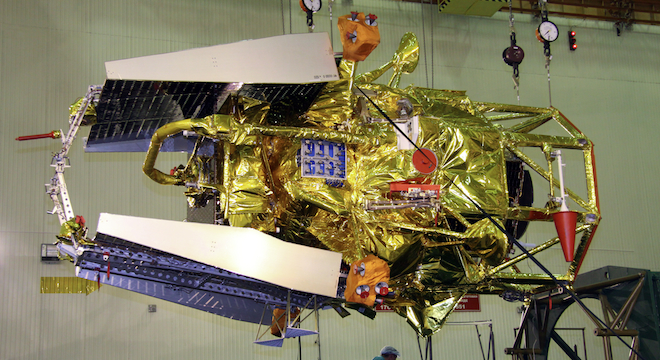TINA CASEY
Phobos-Grunt, an unmanned Russian spacecraft that malfunctioned shortly after launch in November 2011 and was stuck in Earth’s orbit for the two months thereafter, apparently broke up and plunged harmlessly into the Pacific Ocean on Sunday, though the final resting place of any surviving debris has yet to be confirmed, according to Russian news outlet Itar-Tass.
At the time of this post, the latest statement from Russian defense officials to Russian news outlet Ria Novosti indicated that “fragments” fell into the Pacific about 770 miles off the coast of Wellington Island, Chile. The European Space Agency was double-checking its own readings to reconfirm that assessment.
Still, that’s great news on one hand, considering the nearly 15-ton craft was one of the heaviest manmade objects ever to plummet back to Earth, and that it was carrying up to 12 tons of highly toxic rocket fuel (hydrazine), which had sparked fears of potential harm to life back on the ground. However, the fuel was stored in tanks that presumably exploded upon re-entry, Ria Novosti reported.
But the crash once again sends Russia’s renewed space ambitions to an ignominious conclusion. This was the country’s 18th failed Mars mission in the last 52 years and outgoing Russian President Dmitry Medvedev in late November made ominous statements suggesting that engineers and officials of Russia’s space agency, Roscosmos, could face criminal penalities for space mission failures. Russia’s Deputy Prime Minister Dmitry Rogozin said “I am taking the investigation into the reasons for the Phobos-Grunt failure under personal control,” according to Ria Novosti.
Beyond that, the failure of the Phobos-Grunt was also the disappointment of two of Russia’s international space partners on the mission: Phobos-Grunt’s payload included the Chinese satellite Yinghuo-1, which was set to orbit Mars, and a life-science experiment of living bacteria cultures from the German Aerospace Center.
Roscosmos launched Phobos-Grunt (grunt is Russian for “soil”) from the Baikonur Cosmodrome in Kazakhstan on November 9 but soon lost radio contact, and the spacecraft failed to perform a scheduled burn that would have propelled it out of its Earth orbit.
By December 2, the European Space Agency, which had attempted to lend a hand in re-establishing contact with the Phobos-Grunt mission, gave up on its last-ditch rescue attempt, citing an inability to send commands to the probe from its ground stations, or to receive any response.
From that point on, the Phobos-Grunt was on a death-spiral watch.
Roscosmos chief Vladimir Popovkin intimated that sabotage, potentially by the U.S., could be at the root of the mission’s failure, ABC News reported, translating from Russian daily newspapers. However, U.S., security experts cited by ABC News speculated that the cause was a lack of funding, which forestalled sufficient pre-launch testing.
Regardless of the cause, the loss of Phobos-Grunt is a significant blow to the advance of space exploration. The mission would have landed a solar-powered probe on Phobos, one of the two moons orbiting Mars, loaded with equipment to analyze the Phobian soil. A robotic arm would have also collected soil samples and packed them into a capsule for return to Earth for additional study.
Aside from the loss of a $165 million spacecraft, the collapse of the Phobos-Grunt mission is somewhat ironic given that the object of its study is on a death-spiral of doom of its own. The Phobos moon is on a collision course with its host planet Mars, and when that happens the mystery of its origins will that much harder to determine.









